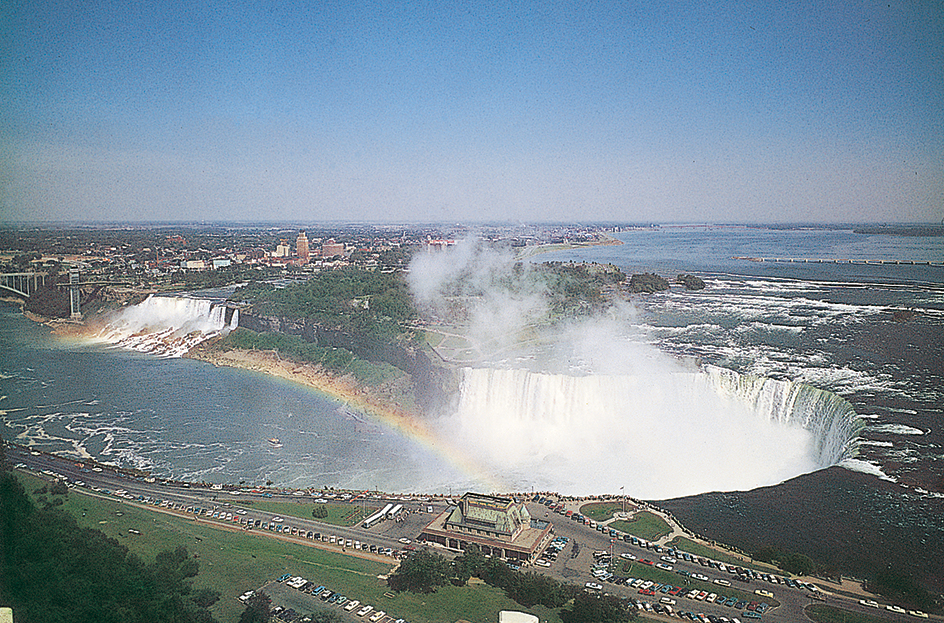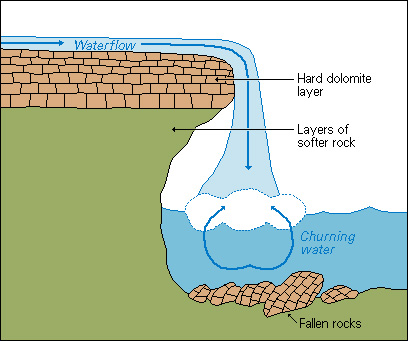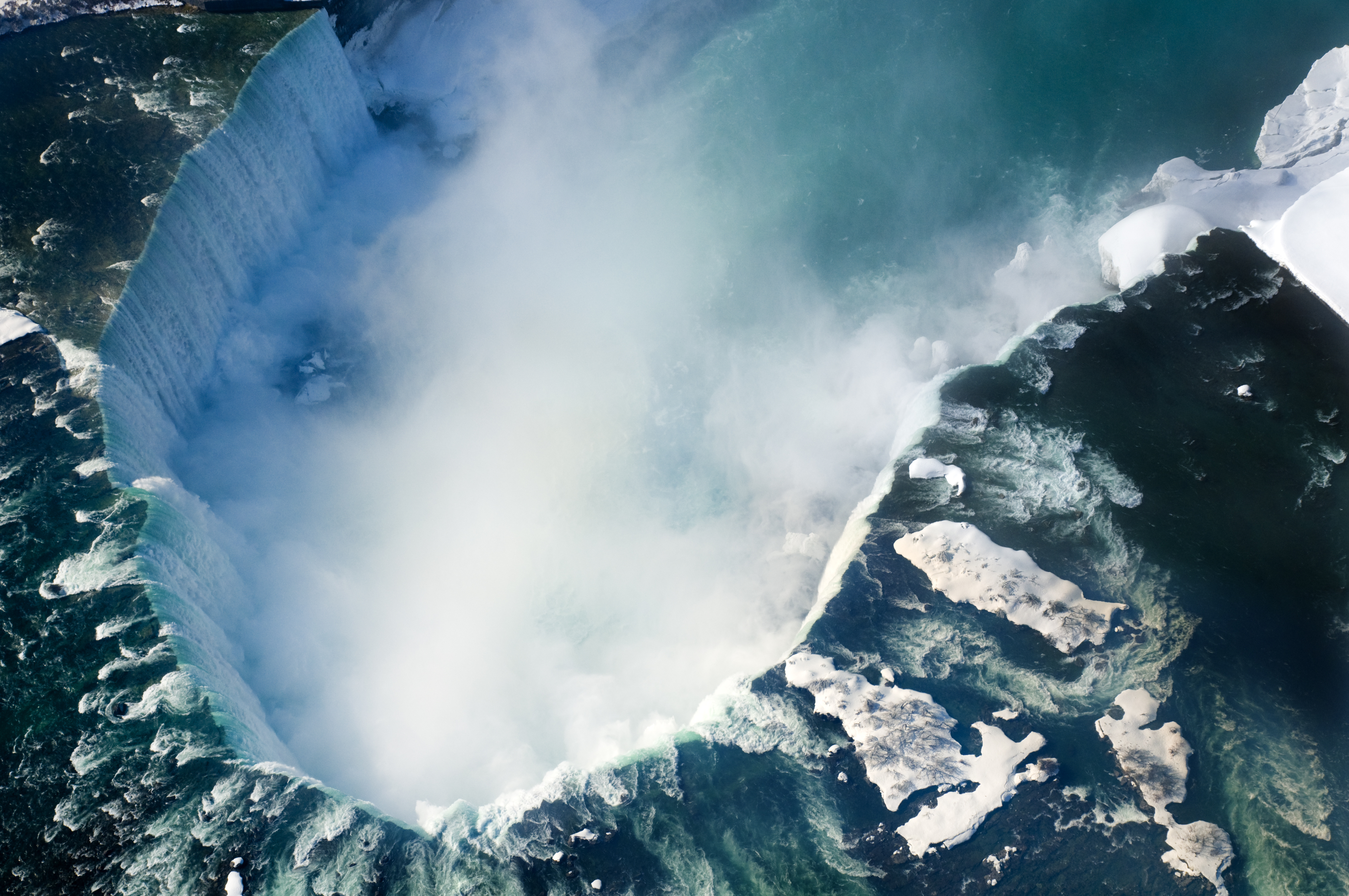Niagara Falls is one of the most spectacular natural wonders of North America. Niagara Falls is on the Niagara River, about halfway between Lake Erie and Lake Ontario. The river forms part of the United States-Canadian border. 
Niagara Falls actually consists of two waterfalls, the Horseshoe Falls and the American Falls. The Horseshoe Falls is on the Canadian side of the border in the province of Ontario. The American Falls is on the United States side in the state of New York. At night, wide beams of colored lights illuminate the falls. Millions of people visit Niagara Falls annually.
Description.
At the falls, the Niagara River plunges into a steep, canyonlike gorge. The gorge extends beyond Niagara Falls for about 7 miles (11 kilometers), to Lewiston, New York. The famous Whirlpool Rapids begin about 3 miles (5 kilometers) below the falls. Here, the violent current has carved a round basin out of the rocks. 
About 85 percent of the water at Niagara Falls flows over the Horseshoe Falls. The Horseshoe Falls is about 167 feet (51 meters) high and 2,600 feet (792 meters) wide at its widest point. The American Falls is about 176 feet (54 meters) high and 1,000 feet (305 meters) wide.
The gorge is about 200 feet (61 meters) deep and consists of layers of different kinds of stone. A hard rock called dolomite about 80 feet (24 meters) thick forms the top layer. It covers softer layers of limestone, sandstone, and shale. Water erodes soft stone faster than hard stone. For this reason, the top layer extends beyond the lower layers in many places. The Cave of the Winds, behind the American Falls, has been formed under an extended shelf of harder stone.
Through the years, the gorge has become longer and longer. The pounding water erodes the soft underlying rock layers, which causes the unsupported hard rock ledge to collapse. Niagara Falls was originally at Lewiston, but it has gradually moved about 7 miles (11 kilometers) back upstream toward Lake Erie. The ledge of the Horseshoe Falls wears away at a rate varying from about 3 inches (8 centimeters) to as much as 6 feet (2 meters) per year. The ledge of the American Falls erodes more slowly because less water flows over it. Each year, about 1 inch (2.5 centimeters) wears away.

Tourism.

Niagara Falls attracts visitors throughout the year. However, most visitors come during the tourist season, from April 1 to October 31. Several steamers called The Maid of the Mist take sightseers close to the churning waters at the base of the falls. Parks line both sides of the river near Niagara Falls. Excellent views of the falls may be seen from such sites as Prospect Point, Table Rock, and Terrapin Point. Four observation towers, ranging from 282 to 500 feet (86 to 150 meters) high, also provide fine views of the falls.
Water flow.
United States and Canadian hydroelectric plants divert some of the water through tunnels from the Niagara River before it reaches Niagara Falls (see Niagara River (Water power) ). For scenic reasons, however, the amount of water that may be diverted is regulated by a treaty between the United States and Canada. The treaty states that at least 100,000 cubic feet (2,800 cubic meters) of water a second must pass over the falls during daylight hours of the tourist season. At other times, the flow may be decreased to 50,000 cubic feet (1,400 cubic meters) a second.
History.
Niagara Falls was probably formed about 12,000 years ago, after the last great ice sheet melted from the region. The melting ice caused Lake Erie to overflow. The overflow formed the Niagara River. The river ran northward over a high cliff called the Niagara Escarpment. The Niagara River cut through the escarpment and, over the centuries, formed Niagara Falls.
Indian tribes lived in the area long before the first Europeans arrived. The name Niagara comes from the Iroquois word Onguiaahra, meaning the strait.
Louis Hennepin, a Roman Catholic priest who traveled with the French explorer Robert Cavelier, Sieur de La Salle, left a written account of his visit to Niagara Falls. In a book published in 1683, Hennepin wrote: “These waters foam and boil in a fearful manner. They thunder continually.”
Large numbers of tourists began visiting Niagara Falls during the 1800’s. Many hotels and taverns were built on the American and Canadian sides of the falls. In addition, numerous industries began to operate along the Niagara River.
Some people believed that the rapid development of tourism and industry ruined the scenic beauty of the Niagara Falls area. In 1885, the government of New York took control of the land bordering the American Falls. It then established Niagara Falls Park, covering about 430 acres (174 hectares), on the land. In 1886, Canada established Queen Victoria Park on 196 acres (79 hectares) of land near the Horseshoe Falls. Since the 1880’s, much more land in the Niagara Falls area has been set aside for parks, especially on the Canadian side.
Rock slides have gradually changed the appearance of Niagara Falls through the years. In 1931, about 80,000 tons (73,000 metric tons) of rock fell from the American Falls. Several years later, approximately 30,000 tons (27,000 metric tons) of rock broke off the upper edge of the Horseshoe Falls. In 1954, about 185,000 tons (167,800 metric tons) of rock tumbled from the American Falls and nearby Prospect Point.
In 1969, U.S. Army engineers built a dam to stop the flow of water temporarily over the American Falls. A board of experts from the United States and Canada then studied the rock ledge to determine how to prevent further erosion. However, the board decided that the cost of halting erosion would be too high. It recommended that nothing be done except small measures to improve public safety.

Waterfall crashing
